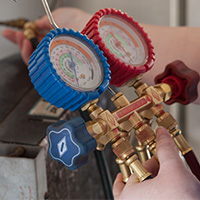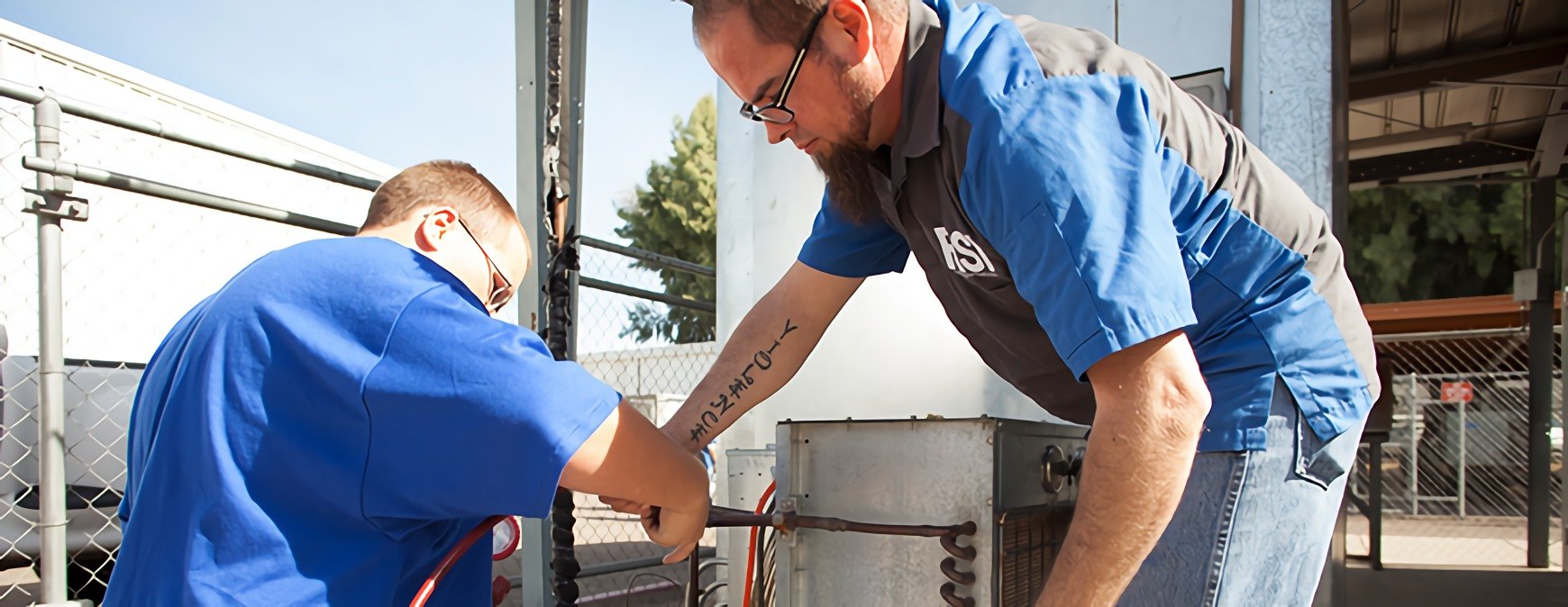RSI is a Great Training Option for Everyone
Learn more about how we can prepare you to advance your career.
When a customer calls on a steamy summer day about a broken-down A/C unit, the tech must diagnose and fix the issue quickly to restore a comfortable temperature to the home or business.[1]
Troubleshooting equipment problems is one of the main skills required to be an HVAC technician.
And it’s this reliance on HVAC technicians to repair and replace faulty equipment that will likely provide job security in the coming years, reports the Bureau of Labor Statistics.[2]
So, what are some of the most common issues with HVAC systems?
Common HVAC System Problems and Their Fixes
1. Air Conditioner: Improper Cooling or Ventilation
If customers complain that the home isn’t getting enough cooled air, then the air filters or registers may be clogged with dust or debris.
Get Started on the Path to a New Career
Fill out our form to learn how we can help you change your life.
Clogged Air Filters
The purpose of HVAC air filters is to trap and collect particles of dust and pollutants from the HVAC unit. The fuller the filter gets, the less air it allows to pass through it.
It’s can be an easy fix: just change the air filter and recommend monthly replacement as part of a routine HVAC maintenance program.
If the HVAC system still isn’t providing enough conditioned air to the home after replacing the filter, the evaporator coil may have to be defrosted.[3]
Dirty Registers
Another source of blocked air flow in homes with forced-air cooling and heating systems can be dirty registers. They should be vacuumed on a regular basis and never obstructed by furniture or other items.[4]
2. Air Conditioner: Cycling Constantly or Erratically
These days, it seems like everything operates off sensors. If your customers’ A/C won’t stop cycling or is cycling wildly, the thermostat sensor could have been knocked out of place. Bend the thermostat wire holding the sensor in place to move it near the coil, but make sure they don’t touch.[5]
3. Heat Pump: Overactive During Mild Temperatures
If a customer’s heat pump runs nonstop during mild spring or fall conditions, it may need to be serviced. Start by removing ice from around the unit and insulating it if located outdoors. Next, clean and service the heat pump.
In the event that maintenance doesn’t fix the problem, inspect the home’s ductwork. Oversized or poorly maintained ductwork could be allowing heat to escape, causing the unit to operate longer to warm the home. Seal gaps in the ductwork. Advise the homeowner to replace the ductwork altogether if none of the above approaches works.[6]
4. Gas Furnace: Failing to Heat the Home
There’s nothing worse than a broken furnace on a freezing winter night. Fortunately, there are a number of simple fixes you can try before making costly repairs:
- Open heat registers.
- Make sure the thermostat is set to heat.
- Check the circuit breaker, fuses and electrical switch to ensure the unit is getting power.
- Hit the reset button.
- Properly shut the service door cover.
- Change filter if dirty.
- Relight the standing pilot light if out (replace thermocouple or ignition if the pilot light won’t stay lit).
- Clean the flame sensor.
If none of these measures above works, you may have a bigger service issue on your hands. Failure for the intermittent pilot light to come on in newer, energy-efficient furnaces could mean there is an issue with the assembly. In the event that the intermittent pilot light comes on but doesn’t keep the burner ignited, the hot surface ignitor may have to be replaced.[7]
Once the problem is fixed, recommend routine furnace maintenance to reduce the frequency of breakdowns and extend the lifespan of the unit.
5. Boiler: Water Leaks
Are your customers finding puddles of water around their boiler? Leaks could be the culprit. Following are some of the potential fixes:
✓ Replace the Pressure-Relief Valve.
- Valves that close or discharge water may need to be replaced.
✓ Service the Pressure-Relief Valve.
- Leaking valves may be the result of a water-filled expansion tank or a seat filled with sediment. After turning off the boiler and allowing it to cool, try lifting the manual pressure relief lever to discharge some water. If it’s still leaking, open the valve again and release water a second time.
✓ Replace the Pump Seal.
- This could address a leaking circulator.
✓ Repair Pipes.
- Trace the leak to the faulty connection in the pipe. Shut off water and repair.[8]
As with furnaces, routine boiler maintenance can prevent malfunctions and prolong the life of the equipment.
Learn How to Troubleshoot HVAC System Problems

The list above covers some of the issues you might encounter while working in the field as an HVAC technician.
If you want to learn the fundamentals of HVAC system troubleshooting, you might want to consider enrolling in an HVAC program at a trade school. RSI offers a course called “Advanced Troubleshooting” as part of its six-month Refrigeration Technologies Training Program. You can learn more by contacting the school online.
Additional Sources
[1] https://www.bls.gov/ooh/installation-maintenance-and-repair/heating-air-conditioning-and-refrigeration-mechanics-and-installers.htm#tab-2
[2] https://www.bls.gov/ooh/installation-maintenance-and-repair/heating-air-conditioning-and-refrigeration-mechanics-and-installers.htm#tab-6
[3] https://www.brighthubengineering.com/hvac/129254-four-most-common-hvac-issues-and-how-to-fix-them/
[4] https://www.consumerreports.org/air-conditioners/troubleshooting-air-conditioner-problems/
[5] https://www.energy.gov/energysaver/common-air-conditioner-problems
[6] https://www.brighthubengineering.com/hvac/129254-four-most-common-hvac-issues-and-how-to-fix-them/
[7] https://www.thespruce.com/problem-gas-furnace-produces-no-heat-4109513
[8] https://www.thespruce.com/repairing-a-hot-water-boiler-1824781
This blog has been labeled as archived as it may no longer contain the most up-to-date data. For a list of all current blog posts, please visit our blog homepage at https://www.rsi.edu/blog/




